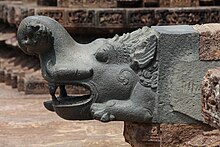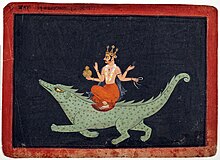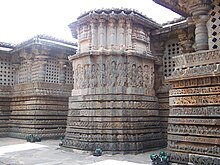Makara
 Makara at the Konarak temple | |
| Country | India |
|---|---|
Makara (
Makara appears as the
Etymology

Makara is a Sanskrit word which means "sea-animal, crocodile".[3]
Josef Friedrich Kohl of
Physical features of makara
It is generally depicted as half terrestrial animal in the frontal part (stag, deer, or elephant) and half aquatic animal in the hind part (usually of a fish, a dolphin, or a snake, though sometimes a peacock or even a floral tail is depicted). Though Makara may take many different forms throughout Hindu culture, in the modern world, its form is always related to the marsh crocodile or water monitor.
According to an art historian,
In Sinhalese ancient artwork Makara is made up of body parts of six or seven animals such as the trunk of the
Iconography
Vedic era iconography
During

Vishnu's earrings are shown in the form of Makara;
Makara has been depicted typically as half mammal and half fish. In many temples, the depiction is in the form of half fish or seal with head of an elephant. It is also shown in an abstract, chimeric form with head and jaws of a crocodile, an elephant trunk with scales of fish and a peacock tail. Lakshmi sitting on a lotus is also a depiction in which she pulls the tongue of the elephant shaped makara is meant to project Lakshmi's image as the goddess of prosperity, wealth and well being.[8][15][14] It represents a necessary state of chaos before the emergence of a new state of order.[8]
Makara is also the emblem of Kamadeva, the god of love and desire. Kamadeva is also known as 'Makara-Ketu' which means "having the makara for an emblem". It is the tenth sign of the Zodiac, called rāśi in Sanskrit, which is equivalent to the zodiacal sign of Capricorn (goat symbol).[11]
Middle kingdoms iconography - Pradyuma Makaradhvaja
From the 2nd century BCE, the Makara appears to have been the symbol of
Later Hindu iconography
Universal frequent occurrences

In Hindu
The leading Hindu
Traditionally, a makara is considered to be an aquatic mythical creature. Makara has been depicted typically as half mammal and half fish. Some traditional accounts identify it with a

In many temples, the depiction is in the form of half fish or seal with head of an elephant. It is also shown with head and jaws resembling a crocodile, an elephant trunk with scales of fish and a peacock tail.
In a Hindu temple, the Makara often serves as the structural

Medieval South Indian iconography
In the medieval era of South India, Makara was shown as a fifth stage of development, symbolized in the form of an elephant head and body with an elaborately foliated fish tail. Most myths maintain this symbolism of this stage in the evolution of life.[14] (Note makara in fifth row of animistic carvings in temple wall at right.)
Indonesian iconography
The
Khmer iconography

Makaras are also a characteristic motif of the religious Khmer architecture of the Angkor region of Cambodia which was the capital of the Khmer Empire. Makaras are usually part of the decorative carving on a lintel, tympanum, or wall. Makaras are usually depicted with another symbolic animal, such as a lion, naga or serpent, emerging from its gaping open mouth. Makara are a central design motif in the beautiful lintels of the Roluos group of temples: Preah Ko, Bakong, and Lolei. At Banteay Srei, carvings of makaras disgorging other monsters were installed on many of the buildings' corners.[26]
Nepalese iconography
The
Most spouts of old Nepalese drinking fountains (called dhunge dhara) have the shape of a makara.[27]
Sri Lankan iconography

Makara is the Sinhala term for dragon, an important figure in Sinhala Buddhist culture in Sri Lanka. It is depicted on toranas in temple architecture and objects of prestige such as in kastanes.
The Makara is widely used in Sri Lankan Buddhist architecture, often depicted on
The
The
A figure of Makara has been carved to the handle of a temple key of Gadaladeniya Temple built in 1344 in Diggala in Kandy District.[32]
The Makara has also been used as a clan symbol by the Karavas and Karaiyars of Sri Lanka, who both share similar origin and were collectively known as Kurukulam.[33][34] Since at least 14 century AD, they have used Makara flags in their ceremonies.[35] Clan titles such as Aditya and Varunakulasuriyan were used by them, to indicate their connection to ancient Hindu god Varuna.[36]
Tibetan Buddhist iconography
In the Tibetan Buddhist format it evolved from the Indian form of makara. However, it is different in some ways such as, "display of lions fore paws, a horse's mane, the gills and tendrils of a fish, and the horns of a deer or dragon. From its once simple fishtail, sometimes feathered, now emerges as a complex spiraling floral pattern known as makara-tail design (Sanskritmakaraketu)".[11]
In Tibetan iconography, it is depicted in the Vajrayana as a weapon of strength and tenacity. The Vajrayan weapons which have makara symbolism are: axe, iron hook, curved knife, vajra, and ritual dagger, in all of which the theme is "emergence of the blade from the open mouth of the makara".[11]
Its symbolic representation in the form of a makara head at the corner of temple roofs is as water element which also functions as a "rainwater
Distribution of iconography
Stone sculptures of the mythological Makara and its ancient place in the iconography of Hinduism and Buddhism are widely spread throughout South Asia and Southeast Asia. Examples from ten countries are shown below:
- Makara sculptures throughout South Asia and Southeast Asia
-
Kaushambi Makara pillar capital, 2nd century BCE
-
Makara atBurma
-
Makara on lintel fromKampong Thom City, Cambodia
-
Makara fromNorthern Qi Dynasty (CE 550-577), China
-
Makara sculptures at theCandi KalasanTemple, Indonesia
-
Hiti Manga in the Balaju Water Garden. Almost allstone tapsin Nepal depict this Makara
-
National Museum of Vietnamese History
-
Makara pandol over the image of Buddha in Dambulla cave temple, Sri Lanka.
-
Sasashima ware square bowl, makara design. Edo period, 19th century
-
One of the ribs of a vajra, Ashok Stupa, Patan, Nepal
See also
- Capricorn (astrology)
- Dashavatara
- Gamzee Makara
- Shachihoko
- Vahana
References
- ^ www.wisdomlib.org (2009-04-12). "Makara, Makāra, Mākara, Mākāra: 44 definitions". www.wisdomlib.org. Retrieved 2022-10-13.
- JSTOR 3250095.
- ^ Apte, V. S. (1957). "मकर". The Practical Sanskrit–English dictionary (Revised and enlarged ed.). Poona: Prasad Prakashan. p. 1218.
- ISBN 978-90-04-03892-9
- ISBN 978-90-04-16819-0
- ^ "Jain Studies in Germany (Part 2) @ HereNow4U".
- ISBN 9788120831056, retrieved 2011-01-22
- ^ ISBN 978-1-4027-6536-0. Retrieved 17 January 2011.
- ISBN 978-0500252130.
- ISBN 9788120601055.
- ^ ISBN 978-1-932476-03-3. Retrieved 17 January 2011.
- ISBN 978-1-57607-106-9. Retrieved 17 January 2011.
- ^ The Asian Civilisations Museum A-Z Guide to its Collections. Singapore: Editions Didier Millet, 2003, p. 300.
- ^ a b c Archaeological Institute of America (1970). Archaeology. Archaeological Institute of America. pp. 41–43. Retrieved 17 January 2011.
- ^ a b c d e f Janaki Lenin (2011-01-14), "My Husband and Other Animals - The beast within File:Makara Halebidu.jpg", The Hindu, ARTS » HISTORY & CULTURE, Kasturi & Sons Ltd, retrieved 2011-01-14
- ISBN 978-81-8424-568-4.
- ^ ISBN 978-81-7099-002-4.
- ^ Gupta, Vinay K. (January 2019). "Vrishnis in Ancient Literature and Art". Indology's Pulse Arts in Context, Doris Meth Srinivasan Festschrift Volume, Eds. Corinna Wessels Mevissen and Gerd Mevissen with Assistance of Vinay Kumar Gupta: 81.
- ISBN 978-0-19-005412-0.
- JSTOR 43484068.
- ^ Visible in the back of the image entitled "Lion capital – Udayagiri – 5th century": "Gujari Mahal State Archaeological Museum – Gwalior". Kevin Standage. 15 April 2019.
- ^ ISBN 978-0-19-005411-3.
- ISBN 978-0-391-03287-3. Retrieved 17 January 2011.
- ISBN 978-0-7661-8881-5. Retrieved 17 January 2011.
- ^ Wilkins (2004)", p.373
- ^ Vittorio Roveda (2005), Images of the gods: Khmer mythology in Cambodia, Thailand and Laos, River Books, pp. 209–210
- ^ Dhunge Dhara: A Case Study of the Three Cities of Kathmandu Valley Archived 2021-03-22 at the Wayback Machine by Riddhi Pranhan, Ancient Nepal 116-118, 1990
- ISBN 9780241251263.
- ^ a b Wijesinghe, Mahil (19 Feb 2017). "Lankatilaka Vihara: Magnificent edifice of Gampola era". Sunday Observer. p. 1. Retrieved 11 July 2021.
- ^ "Discover Sri Lanka". Lanka Nest. Archived from the original on 12 December 2013. Retrieved 16 March 2012.
- ^ Fernando, Kishani S. "Ridi Viharaya". Daily Mirror. Retrieved 14 March 2012.
- ^ "Tom Allwood Photography". Tom Allwood. Archived from the original on 25 October 2009. Retrieved 18 March 2012.
- ^ Kurukshetra. Sri Lak-Indo Study Group. 1976.
- ^ Kurukshetra. Sri Lak-Indo Study Group. 1976.
- ^ Lewis, John Penry; Senaveratna, John M.; Bell, Harry Charles Purvis (1922). The Ceylon Antiquary and Literary Register.
- ISBN 9789556591460.
- Dictionary of Hindu Lore and Legend (ISBN 0-500-51088-1) by Anna Dallapiccola
- The Illustrated Book of Signs and Symbols by Miranda Bruce-Mitford
Bibliography
- Perera, ADTA (Sep–Oct 1975). "Makara - crafted with mattock (ගල් කටුවෙන් පණ ගැන්වූ මකරා)". Religious News (ශාසන ප්රවෘත්ති) (in Sinhala). 5 (1–2). Colombo: Religious Division of Department of Cultural Affairs: 6–7.
- Schokman, Derrick (12 April 2003). "The Kusta Raja Gala". Daily News. Retrieved 18 March 2012.


















